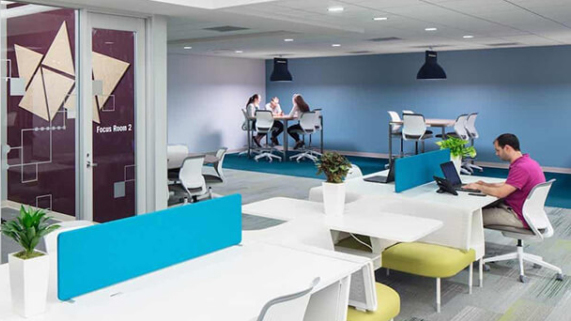How Real-Time Space Measurement is Mitigating the Risk of Today’s Agile Work Trends
“Agile” is a term that has become seemingly ubiquitous when discussing 21st century work trends, but what does it really mean? The term certainly owes its origin to the “agile development” wave popularized by the Agile Manifesto (2001) by Arie van Bennekum, Robert Cecil Martin, and a handful of other software development experts. But today, the term continually evolves to mean something much more. According to the specialists at Boston Consulting Group, agile is a “team-centered, iterative, and cross-functional approach that can be applied across many business contexts.” Today the term is more about responsibility distribution, quick response times, autonomy, and flexibility for the future than strictly a formal development dogma.
Is agile work the future of how we conduct day to day business or is it just a fad? According to research conducted by Randstad (a global human resources consulting firm), today roughly 11% of the global full-time workforce is truly mobile (either contracted, temporary, or without dedicated long-term space), but it is projected to make up as much as 68% by 2025. Extensive surveys conducted by CBRE and CoreNet show that roughly 25% of employers are placing at least some employees in unassigned seating, and 52% plan to do so within three years. With this information, it should come as no surprise that co-working giants like WeWork, Convene, and Spaces are becoming evermore common to meet the flexible needs of the highly agile, more mobile workforce.
So agile work is a growing trend showing no signs of slowing down, but are organizations really engineered to fully understand, implement, and test their work environments to gauge the success of these new initiatives? Unfortunately for most organizations, the answer is no. In fact, 71% of companies deem themselves to have low agility fluency with an average agility fluency score of 4.9/10 according to the Business Agility Institute’s 2018 report. Innovation requires taking risks and being flexible, but very few organizations are adopting an agile work strategy without friction.
With so much changing in the workspace and with most companies admittedly trailing their ideal agile strategy, how are these organizations tracking progress in the physical workspace? Some of the most common methods of measuring employee trends include surveys, badge data, and physical “bed checks”—or what typically translates to a facilities professional using a clipboard to see where employees are working and how full meeting spaces are. Unfortunately, many of these “tried and true” tracking methods are either outdated, inaccurate, or inefficient: surveys are skewed by non-responders and vocal individuals, badge data often omits employees who enter in groups and doesn’t track exiting, while “bed checks” can be very time consuming and only capture singular occupancy snapshots.
Leading agile organizations have recognized the gaps in their measurement capabilities and are now turning to newer, more accurate, and more cost-effective methods of understanding both their employees and their workspace. Originally developed in the 1970s for military use, infrared or IR sensors have since been adapted to detect motion and heat in an area. When placed under a chair or desk, the IR sensor is one of the more basic ways to detect workspace occupancy. However, within the last decade, sensors detecting how individuals interact in a space have become increasingly sophisticated.
Sensor data on occupancy and headcount, Wi-Fi network usage, and booking data all provide valuable metrics and when combined deliver highly informed insights with which to gauge employee habits and usage trends. More specifically, companies like AVUITY are leveraging optical sensors to not only measure meeting rooms, but also hoteling spaces, lounge areas, work cafes, and shared collaboration areas. With the recent developments of Artificial Intelligence and Machine Learning, not only are we now using sensors to measure people, but also to differentiate objects, record temperature, lighting, and sound levels. The newest VuAI sensor will soon be able to gather all of these disparate data points and run them through an AI platform utilizing machine learning + existing facility data to give a comprehensive, accurate, and affordable system for understanding your workplace.
Arming organizations with the ability to measure their changing workplace is a key benefit, but leveraging this information to improve employee experience is the final step to future-proofing your business in today’s agile landscape. The newest sensor technology not only equips leaders with the tools to accurately gauge their space, but also extends this space understanding as a tool to the end users with mobile booking, wayfinding, real time interactive mapping, and intelligent booking that allows employees to find the right sized space with the right amenities all from their mobile device. Moving to a more mobile working strategy is far less risky when your organization has the right tools to measure progress and arm end users with the ability to leverage technology to find and use space efficiently. Change can be risky. Agile work can encourage iteration and uncertainty. But with continued developments in technology and organizations like AVUITY are helping to make the today’s workplace trends far less scary.
- https://www.bcg.com/en-us/digital-bcg/agile/default.aspx
- https://www.randstadusa.com/workforce360/2017-workplace-2025/
- https://www.cbre.us/research-and-reports/Americas-Occupier-Survey-2018?mod=article_inline
- https://agilityhealthradar.com/wp-content/uploads/2018/08/BAI-Business-Agility-Report-2018.pdf


